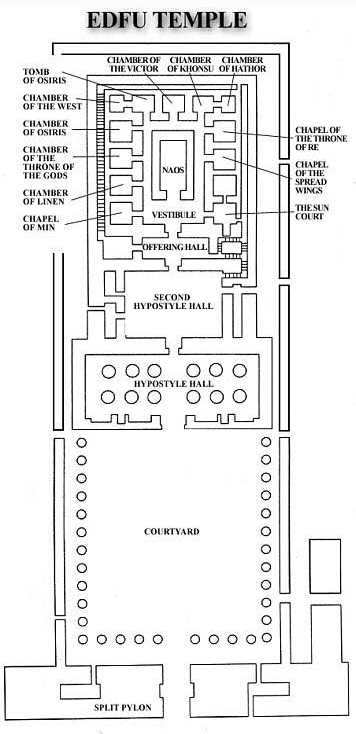 |
Get free, Get freedom |
|
|
|
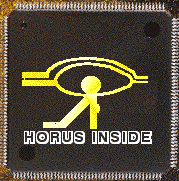
Is the Temple of
Horus at EDFU, Egypt a CPU?
 Back on March 2nd of 1999, Richard Hoagland made an
appearance on a FOX special called "Opening the Lost Tombs". The program showed
different opinions regarding the ancient mysteries of Egypt. Mainstream
Egyptologists and thinkers like Zahi Hawass maintain that the ancient Egyptians
built all of the monuments like the Sphinx and Pyramids and steadfastly
maintains that any other theory is ridiculous.
Back on March 2nd of 1999, Richard Hoagland made an
appearance on a FOX special called "Opening the Lost Tombs". The program showed
different opinions regarding the ancient mysteries of Egypt. Mainstream
Egyptologists and thinkers like Zahi Hawass maintain that the ancient Egyptians
built all of the monuments like the Sphinx and Pyramids and steadfastly
maintains that any other theory is ridiculous.
Alternative researchers like Hoagland suggested that the monuments of Egypt were built by a previous high-tech civilization. One piece of evidence put forth on the FOX special showed a glyph at a temple in Abydos, Egypt. The particular glyph had several bizarre, high-tech looking objects;
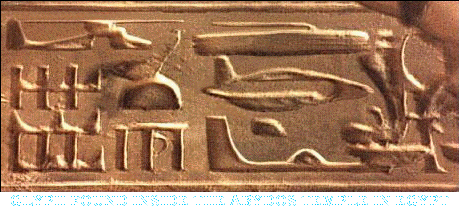
One of the most striking features on this glyph was a character that resembled a helicopter.

This glyph was found in a Temple that was originally built by Seti the 1st in Abydos which was a cult center dedicated to the worship of Osiris. Was this the only evidence in Egypt regarding the residual memory of a pre-history, high-tech civilization? It was until a discovery made by Daniel Perez, who maintains this website.
During the course of surfing the internet for information to create a web page on a completely different subject, Perez came across a website showing the Temple of Horus in Edfu, Egypt. This temple was built for the worship of Horus, the son of Osiris who avenged his father's death.
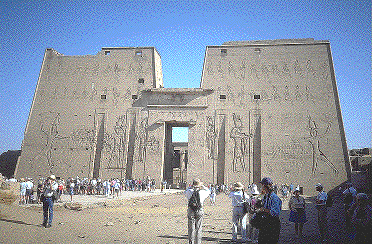
On this same web page was a map of the Temple of Horus.
Upon looking at this image and basing his observations on his knowledge of electronics, Perez noticed that the Eastern End of the temple (top of image) looked very similar to the structure of a microprocessor. What got Perez's attention was the closely spaced lines on the right side (north side) of the temple.
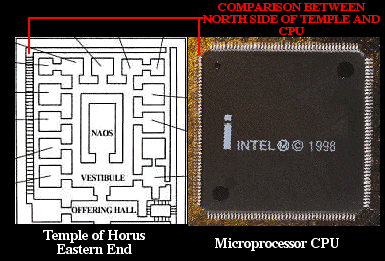
Then looking at the whole image, it became glaringly obvious that the entire Temple of Horus correlated with components of a CPU and surrounding hardware that's found in modern day computers.
Each section of the Temple of Horus correlated with a segment of a CPU and the surrounding hardware needed for a CPU to function.
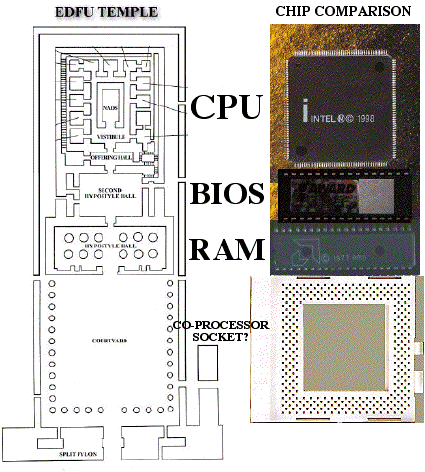 THE CPU / INNER SANCTUARY
THE CPU / INNER SANCTUARY
The most important part of the Temple of Horus, the Eastern end, has a similar structure to the interior of a CPU. The smaller sections consist of Chambers surrounding an Offering Hall, a Vestibule and an area called the Naos, which in ancient Egyptian tradition contains the most important part of this particular temple, a statue of the god Horus.
The Chambers surrounding the Eastern End of the Temple would logically be places to store objects or information, perhaps for later use in a ritual. Inside a CPU, segments known as registers perform the task of storing information to be processed later.
The next inner chamber is a Vestibule, which is defined in Webster's Dictionary as "a course that offers access (as to something new)." In a similar matter, the arithmetic and logic section of a CPU offers a the outer sections of a microprocessor access to the main area called the Control Unit.
The NAOS, is obviously the center of the temple and symbolically controls and works in tandem with all of the rituals and tradition surrounding it. In a similar fashion, the Control Unit of a CPU controls and works in tandem with all of the other sections of a microprocessor.
The lower right of the temple's inner sanctuary (CPU area) are two small sections which resemble miniature integrated circuit chips which are used in computers as system clocks for a CPU.
At the entrance to this inner section of the Temple of Horus is an area called "The Offering" hall, which contains items to be brought from the "Second Hypostyle" hall. The Cache of a CPU contains data that is to be brought from the outside, especially from the next component of a computer, the BIOS chip.
THE BIOS CHIP / SECOND HYPOSTLE HALL
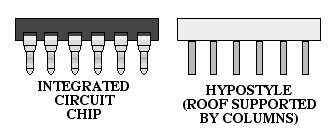 The word "Hypostyle" in Webster's dictionary is defined as
"a roof resting on rows of columns" If you've noticed, any Integrated Circuit
chip, including the BIOS chip looks like a roof resting on rows of columns. The
"roof" would be the body of the chip and the columns would be the metal pins
protruding from the chip.
The word "Hypostyle" in Webster's dictionary is defined as
"a roof resting on rows of columns" If you've noticed, any Integrated Circuit
chip, including the BIOS chip looks like a roof resting on rows of columns. The
"roof" would be the body of the chip and the columns would be the metal pins
protruding from the chip.
The BIOS chip performs the function of "booting up" the CPU by making sure all attachments are in place, transfers control to the BIOS and loads the program to be used into the Random Access Memory (RAM).
In a similar fashion, the "Second Hypostyle" hall is a gathering place to make the temple ready for "god worship" rituals to be performed, temporarily transfers control of the temple to this hall when the "god worship" ritual is about to begin and is used to bring in the tradition of ritual celebration (a program) for those in the next outer "hypostyle" hall who are not skilled enough to be in the inner sanctuary.
RAM / HYPOSTLE HALL
Random Access Memory is a short term memory used to temporarily hold programs to be used by a computer. In the case of the temple, "the computer" is Egyptian Civilization and the "program" is a celebration held in the outer hypostyle hall for those not qualified or required to be in the inner sanctuary or are temporary members.
COURTYARD / A CO-PROCESSOR SOCKET
The open courtyard of this temple has several pillars surrounding it inside of a wall on three sides. A socket which is used to hold a co-processor chip (or Floating Point Unit) on a computer motherboard would be a logical comparison to this area if the "pillars" are interpreted as "holes" and the open area is the hollowed out area of the "socket".
CONCLUSION
The layout of the Temple of Horus resembles the collection of a CPU, a BIOS chip, a RAM chip and a Co-Processor socket found in today's modern computers. Computers obviously didn't exist in Ancient Egypt because they lacked the technology and the knowledge.
Therefore, this tells us the design of the Temple of Horus, as well as the Abydos helicopter glyph, are residual memories of a previous high-tech civilization which disappeared from the face of the Earth thousands of years before modern recorded history began.
|
|
|
Copyright © 2001 New Netizen. All Rights Reserved.
